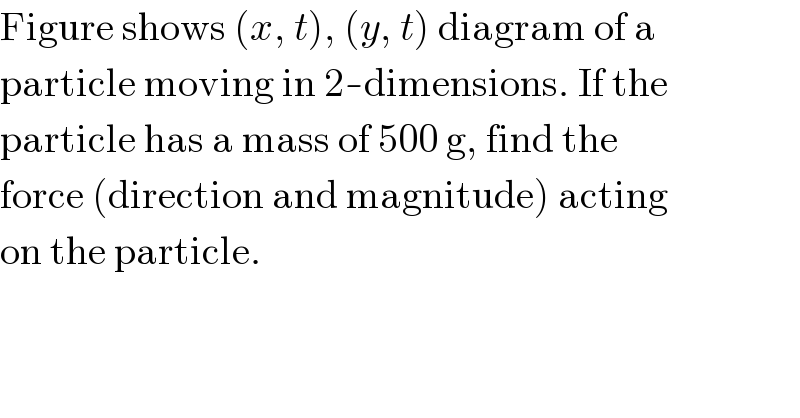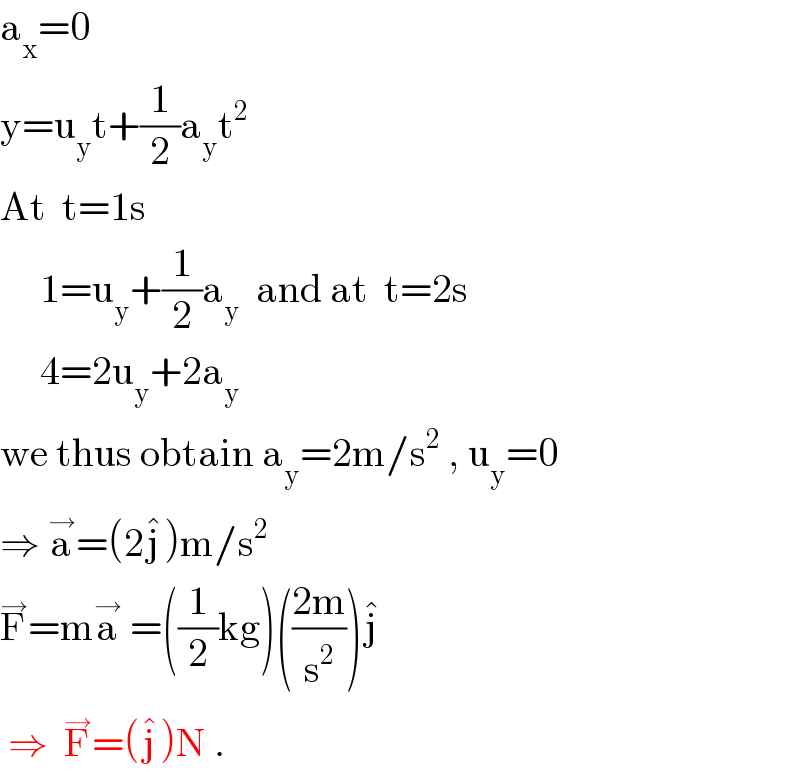
Question Number 19137 by Tinkutara last updated on 05/Aug/17

$$\mathrm{Figure}\:\mathrm{shows}\:\left({x},\:{t}\right),\:\left({y},\:{t}\right)\:\mathrm{diagram}\:\mathrm{of}\:\mathrm{a} \\ $$$$\mathrm{particle}\:\mathrm{moving}\:\mathrm{in}\:\mathrm{2}-\mathrm{dimensions}.\:\mathrm{If}\:\mathrm{the} \\ $$$$\mathrm{particle}\:\mathrm{has}\:\mathrm{a}\:\mathrm{mass}\:\mathrm{of}\:\mathrm{500}\:\mathrm{g},\:\mathrm{find}\:\mathrm{the} \\ $$$$\mathrm{force}\:\left(\mathrm{direction}\:\mathrm{and}\:\mathrm{magnitude}\right)\:\mathrm{acting} \\ $$$$\mathrm{on}\:\mathrm{the}\:\mathrm{particle}. \\ $$
Commented by Tinkutara last updated on 05/Aug/17

Answered by ajfour last updated on 05/Aug/17

$$\mathrm{a}_{\mathrm{x}} =\mathrm{0} \\ $$$$\mathrm{y}=\mathrm{u}_{\mathrm{y}} \mathrm{t}+\frac{\mathrm{1}}{\mathrm{2}}\mathrm{a}_{\mathrm{y}} \mathrm{t}^{\mathrm{2}} \\ $$$$\mathrm{At}\:\:\mathrm{t}=\mathrm{1s} \\ $$$$\:\:\:\:\:\mathrm{1}=\mathrm{u}_{\mathrm{y}} +\frac{\mathrm{1}}{\mathrm{2}}\mathrm{a}_{\mathrm{y}} \:\:\mathrm{and}\:\mathrm{at}\:\:\mathrm{t}=\mathrm{2s}\:\: \\ $$$$\:\:\:\:\:\mathrm{4}=\mathrm{2u}_{\mathrm{y}} +\mathrm{2a}_{\mathrm{y}} \\ $$$$\mathrm{we}\:\mathrm{thus}\:\mathrm{obtain}\:\mathrm{a}_{\mathrm{y}} =\mathrm{2m}/\mathrm{s}^{\mathrm{2}} \:,\:\mathrm{u}_{\mathrm{y}} =\mathrm{0} \\ $$$$\Rightarrow\:\overset{\rightarrow} {\mathrm{a}}=\left(\mathrm{2}\hat {\mathrm{j}}\right)\mathrm{m}/\mathrm{s}^{\mathrm{2}} \\ $$$$\overset{\rightarrow} {\mathrm{F}}=\mathrm{m}\overset{\rightarrow} {\mathrm{a}}\:=\left(\frac{\mathrm{1}}{\mathrm{2}}\mathrm{kg}\right)\left(\frac{\mathrm{2m}}{\mathrm{s}^{\mathrm{2}} }\right)\hat {\mathrm{j}} \\ $$$$\:\Rightarrow\:\:\overset{\rightarrow} {\mathrm{F}}=\left(\hat {\mathrm{j}}\right)\mathrm{N}\:. \\ $$
Commented by ajfour last updated on 06/Aug/17

$$\mathrm{how}\:\mathrm{do}\:\mathrm{i}\:\mathrm{know}\:\mathrm{the}\:\mathrm{degree}\:\mathrm{of} \\ $$$$\mathrm{equation}\:\mathrm{to}\:\mathrm{the}\:\mathrm{y}−\mathrm{t}\:\mathrm{graph}. \\ $$$$\mathrm{this}\:\mathrm{is}\:\mathrm{all}\:\mathrm{that}\:\mathrm{can}\:\mathrm{be}\:\mathrm{done}. \\ $$
Commented by Tinkutara last updated on 06/Aug/17

$$\mathrm{Thank}\:\mathrm{you}\:\mathrm{very}\:\mathrm{much}\:\mathrm{Sir}! \\ $$
